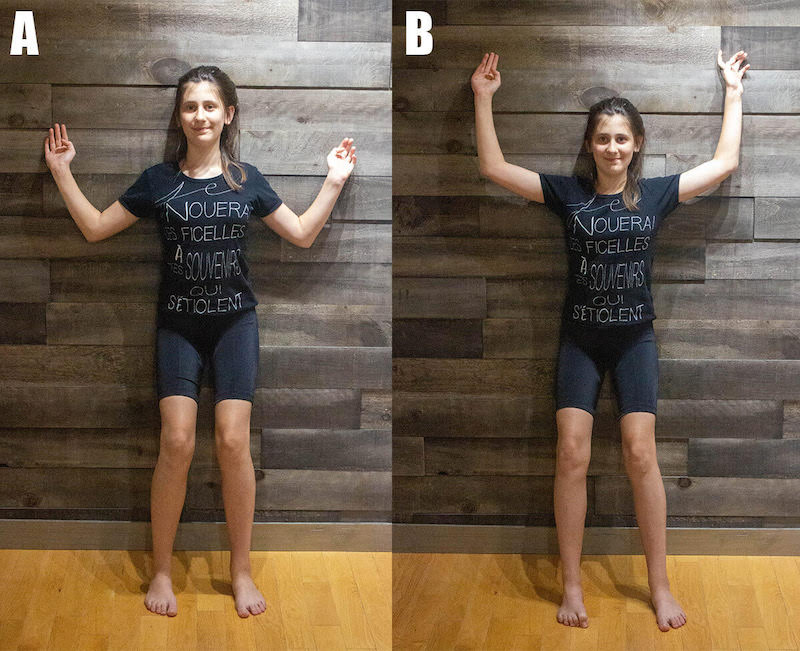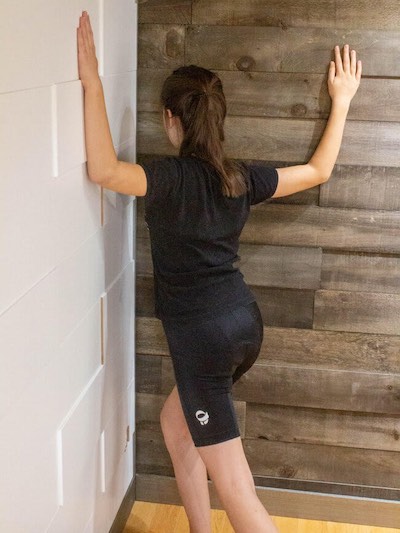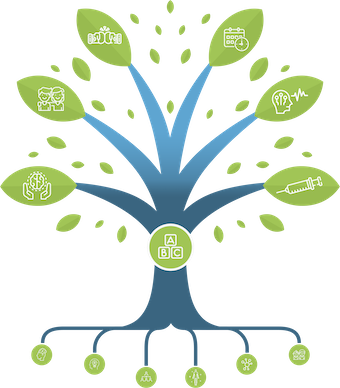Find physiotherapy exercises with migraine
A variety of headaches including cervicogenic headaches, tension headaches and migraine are linked to joint or muscle dysfunctions. If your migraines are influenced by neck and shoulder movements, consider seeing a physiotherapist. The exercises should be adapted to you. There are two major aspects of physiotherapy treatments:
- Strengthen: put a focus on the muscles involved in your posture. (See this post). This may include the abdominal, back, shoulder, and neck muscles. Although everybody is different and does not have the same needs, some exercises are suitable in a majority of cases, including scapular wall slides (Figure 1). Strengthening exercises should be done in 3 sets of 10 repetitions every day.

Figure 1. Wall slide exercise. By maintaining contact with shoulders, elbows and wrists, move back and forth by sliding your arms against the wall, from position A to position B.
- Stretch: sometimes, excess muscle tension will hold the body in a non-optimal position. Stretching exercises can help. Pectoral muscle stretches are one example (Figure 2). Many other stretches can be recommended based on your personal needs. Stretches should be done 3 times per day, one minute each time, with a gentle approach. Ease into it and don’t forget to breathe.

Figure 2. Stretching of the pectoral muscles. While positioned in the corner of a wall or in the middle of a door frame, move the body forward while maintaining both shoulders horizontally.
Scapular stabilization can be an important focus of your exercise program.
For suggestions, see the following program and discuss it with your physiotherapist (See this post).
Can I find useful (and free) exercises on the internet?
The internet can be a good resource, but sometimes a personalized approach is necessary. Tailoring the exercises according to your condition is important, especially if pain is felt during the exercises, or if they don’t seem to provide the desired results.
A useful link:
https://www.spine.org/KnowYourBack/Prevention/Exercise/Cervical-Exercise
How long do I have to do the suggested exercises before seeing results?
You should be able to see a positive effect within 6 weeks. Generally, exercises should be continued at least 3 months for maximum results. The exercises should become part of your routine, and if possible, fun!
Should I keep doing the exercises for the long term?
Discuss a maintenance program with your physiotherapist. Continuing the exercises once or twice a week could help maintain the achievements. It’s not uncommon to let go of your routine when you start getting better. If you’ve let your routine lapse, pain and stiffness may return. Ease slowly back into your program.
Is there a maximum age to benefit from physiotherapy exercises?
No, not at all. The exercises may need to be adapted, but there is no age for improving one’s condition, as long as cognitive abilities make it possible to understand the exercises and do them safely. Group exercises can contribute to social life.
Older adults who are deconditioned generally respond positively to exercises that make them move gently. There is a common saying in physiotherapy that states: “motion is lotion”!
Can children and adolescents benefit from exercises?
Certainly. Many young people have sedentary lifestyles. They go through stressful situations like school performance, busy schedules and social pressure. Hours spent sitting in school, playing on game consoles or tablets can cause painful postures and muscle tensions. The strengthening and stretching approach can also be beneficial in this age group. Young people with concussion may require a multidisciplinary approach including physiotherapy.
What if the exercises cause pain?
In general, mild discomfort during exercises is acceptable. If there is pain, the exercise should be stopped and reviewed with a professional. It is advisable to avoid exercising during migraine attacks. If the exercises trigger attacks, they should be modified, not abandoned.
In summary
Strengthening and stretching can significantly decrease your migraines and improve your quality of life in the long term. Your efforts will pay off!
References
[1] Luedtke K, Allers A, Schulte LH, May A. Efficacy of interventions used by physiotherapists for patients with headache and migraine-systematic review and meta-analysis. Cephalagia 2016;36:474-92.
[2] Jull G, Trott P, Potter H, et al. A randomized controlled trial of exercise and manipulative therapy for cervicogenic headache. Spine 2002;27:1835-43.
[3] Page P. Cervicogenic headaches: an evidence-led approach to clinical management. Int J Sports Phys Ther 2011;6:254-66.
[4] Butler D, Moseley L. Explain pain, 2nd Edition. 2013; NOI Group.
Post#723
Categories
THE MIGRAINE TREE
- BRANCHES
- ACUTE TREATMENTS
- DEVICES AND NEUROMULATIOIN
- PREVENTIVE TREATMENTS
- PROCEDURES AND INJECTIONS
- SELF-CARE AND LIFESTYLE
- SOCIAL LIFE
- TRUNK
- ROOTS
OTHER CATEGORIES




